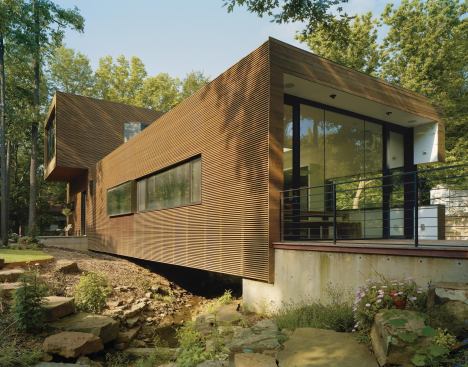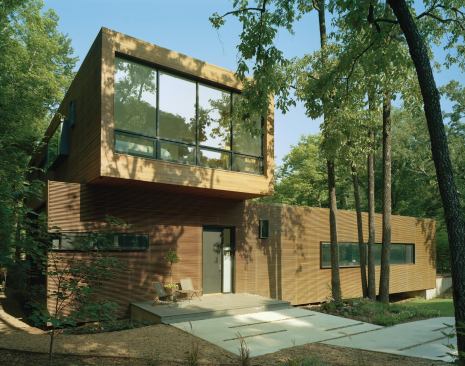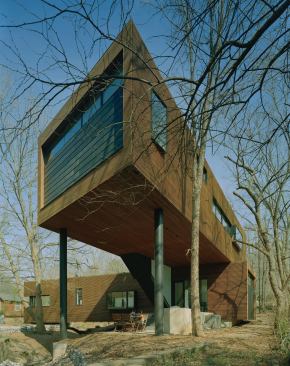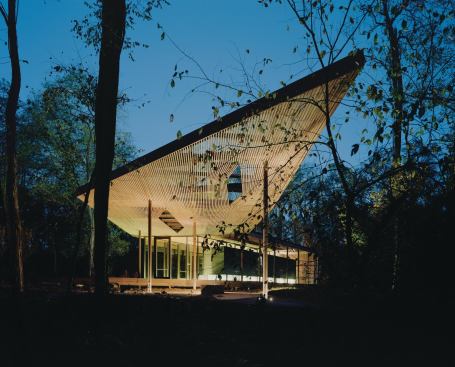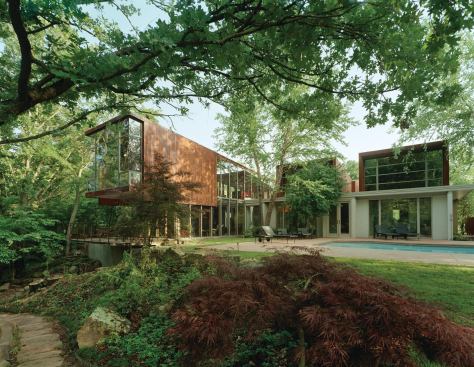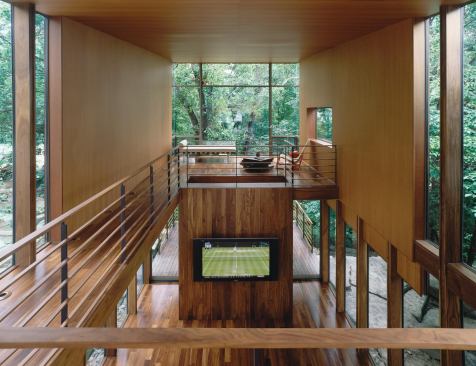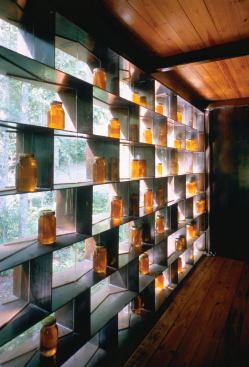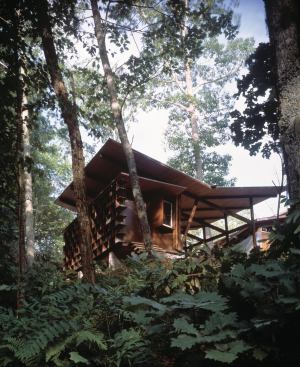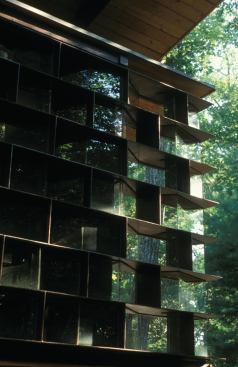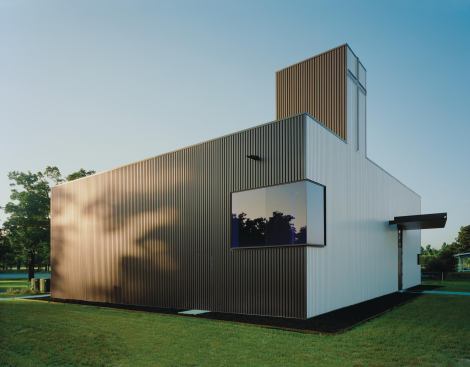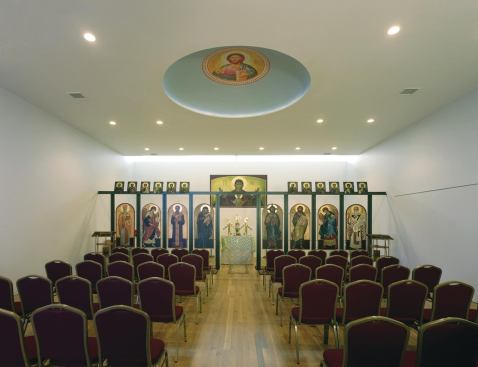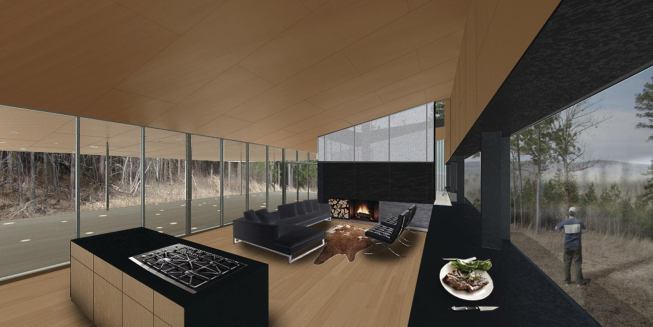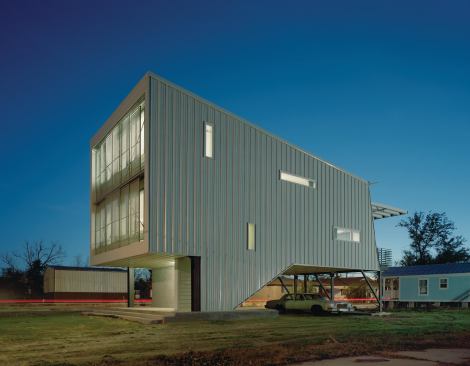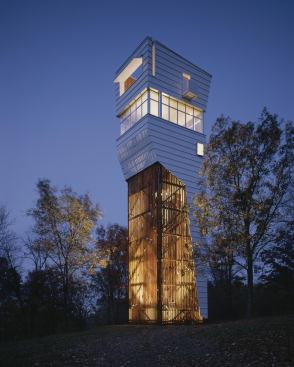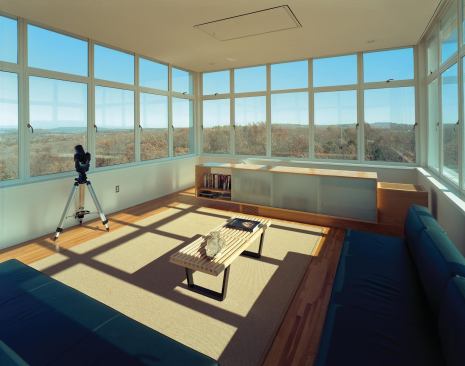Timothy Hursley
The Blackwells' home, known as the L-Stack House, spans a season…
high profile
Over his next few years in Fayetteville, Blackwell gained a deep understanding of the Ozarks’ materiality, culture, and natural environment. He then designed a pair of buildings that rocketed him to national attention. The Moore HoneyHouse (1998) in Cashiers, N.C., ingeniously uses a honeycomblike, steel-and-glass wall of shelves to bring in light, provide structural support, and store and display honey cultivated by the beekeeper client. And the Keenan TowerHouse in Fayetteville (2000) synthesizes the childhood concept of a treehouse with the imagery of an industrial Arkansas tower to create a bold, iconic piece of architecture. The TowerHouse made the cover of Architectural Record, and requests for Blackwell to lecture jumped from two to three per year to 20 per year.
Since then, his firm has steadily turned out award-winning projects, both residential and non-residential. The office now employs eight people, including Marlon and Ati, who is a full partner. “I can’t say the business would be where it is without Ati,” Marlon says. “She’s constantly challenging and pushing me.” After working first at another local firm and then part-time with Marlon when the couple’s two children (now 10 and 12) were younger, Ati has taken on a greater role in the firm’s day-to-day operations, including its financial management. “We share a passion for architecture,” she says of herself and Marlon, who is the design lead on all projects. “Even though we come from two different backgrounds, I understand his sensibility.”
During a slow period in 2009, the Blackwells and their staff moved into a space in a mid-century office building that they renovated for a developer client. “The office is casual and open,” Ati notes. “Marlon and I don’t have special desks. There’s a level of trust we all have with each other.”
The slowdown gave the firm a chance to rethink some of its processes. “We decided three or four years ago that we wanted to do more public work,” Marlon says. “Our goal was to elevate our presence without compromising what we do.” He and his team started trying to land bigger public projects, eventually realizing that one of the best ways to do so is to team up with larger firms. They’re working with DLR Group and Hight Jackson Associates on Fayetteville High School, the first phase of which is under construction now. And along with Polk Stanley Wilcox Architects, Marlon Blackwell Architect is designing a renovation of and addition to Vol Walker Hall at the University of Arkansas.
At the same time, the firm has a private cabin and bunkhouse under construction in Caddo Gap, Ark. A handful of other projects, including a retail store at the Crystal Bridges Museum in Bentonville, Ark., and a Montessori school in Fayetteville, also are under way. “We will always do residential,” says Ati, who served as general contractor for the couple’s own house in Fayetteville, the L-Stack House. (The project won a residential architect Design Award in 2010.)
site centered
Blackwell is widely considered one of the country’s leading regionalists. He interprets the natural and man-made characteristics of a place, weaving them together to create exciting yet site-appropriate buildings. He takes his research seriously: When he and Ati were designing the L-Stack House, they lived in a rental house next door to their property for a year and a half, so they could gain a true sense of the land.
When absorbing the influences of a place, Blackwell doesn’t automatically jettison the ugly in favor of the beautiful; he draws inspiration from both trailers and trees. “I have no interest in making utopias,” he says, and indeed his work conveys a sense of realism—a raw energy and power similar to that of a hand-drawn sketch. At the same time, its restraint, precise detailing, and intimate relationship to the site lend it a refined feeling. “My curtains are the trees and the light and the movement outside,” says residential client John Tyson. “Every time I come into the house, I take a deep breath.”
Even if a project isn’t within Blackwell’s own region of northwest Arkansas, he and his team apply the same process of divining a site’s particular qualities. Last year they completed work on a visitors’ pavilion at the Indianapolis Museum of Art (IMA), one of the firm’s highest-profile and most far-flung projects to date. “It became very clear with his residential architecture, especially the TowerHouse and the HoneyHouse, that it was so unique and incredibly sensitive and specific to the location,” says Lisa Freiman, an IMA senior curator who was instrumental in choosing Blackwell for the job. “His work is so considerate of nature but also thinking about the relationship between natural forms and architecture.”
Blackwell believes his work has grown more liberal in its definition of regionalism. “Increasingly, it’s become a bit more transgressive with the vernacular,” he says. He credits his childhood interest in drawing cartoon strips with making him more aware of the way things live in three dimensions. “Most of our work is generated in profile, more sectionally,” he explains. “I love drawing plans, but it’s important to get out of plan. Looking at things in 3D helps you understand how things hit the ground and sky. I just think how something meets the ground is really important.”
His favorite work by other architects sometimes shares the abstract forms of his own work—and sometimes not at all. “I love the Seaside Chapel,” he says of Merrill, Pastor & Colgan Architects’ pristine, Carpenter Gothic–influenced chapel in Seaside, Fla. “I would never do that, but it’s damn good. To me it’s not about style. It’s about a disciplined approach.”
Since 2009, Blackwell has chaired the architecture department at the University of Arkansas. He still teaches fourth and fifth-year studios, with the help of a teaching partner, and has served as a visiting professor at other schools including MIT, Auburn, and the University of Florida. He’s received offers to leave Fayetteville, but has always chosen to stay. Living and working there enables him, Ati, and their firm to continue the tradition of Fay Jones and other significant local architects, which has become something of a mission for him.
“I feel like if I left I’d be abandoning part of what I set out to do, which was to say, ‘Hey, man, why can’t design happen here in Arkansas?’” he says. “Fayetteville is a strange place, and I’m sort of attracted to strangeness. We’re not making things up—we’re building on a legacy here. It’s a cool place.”
